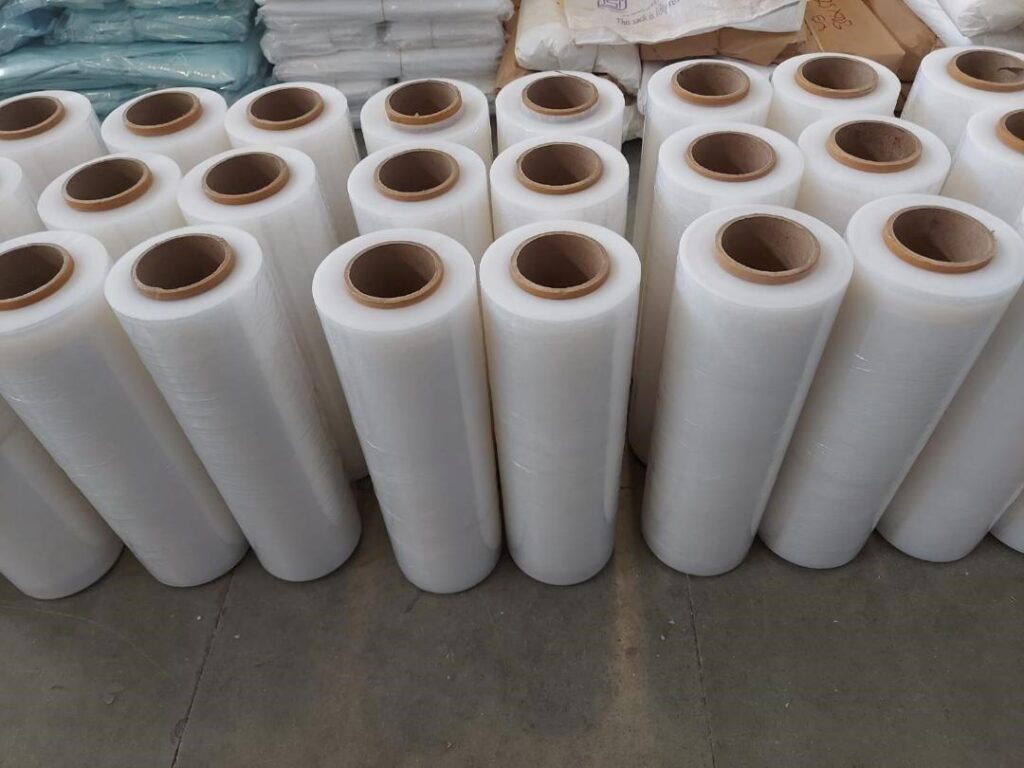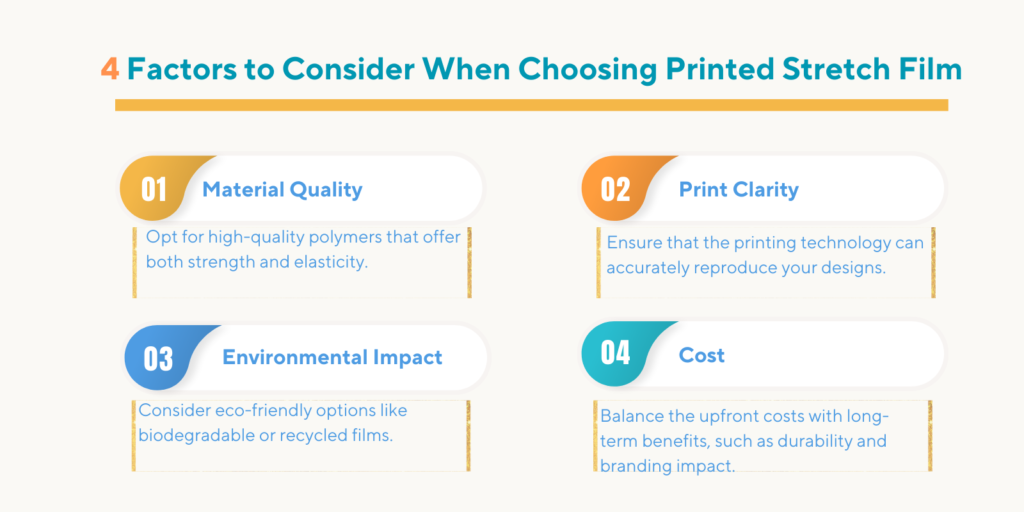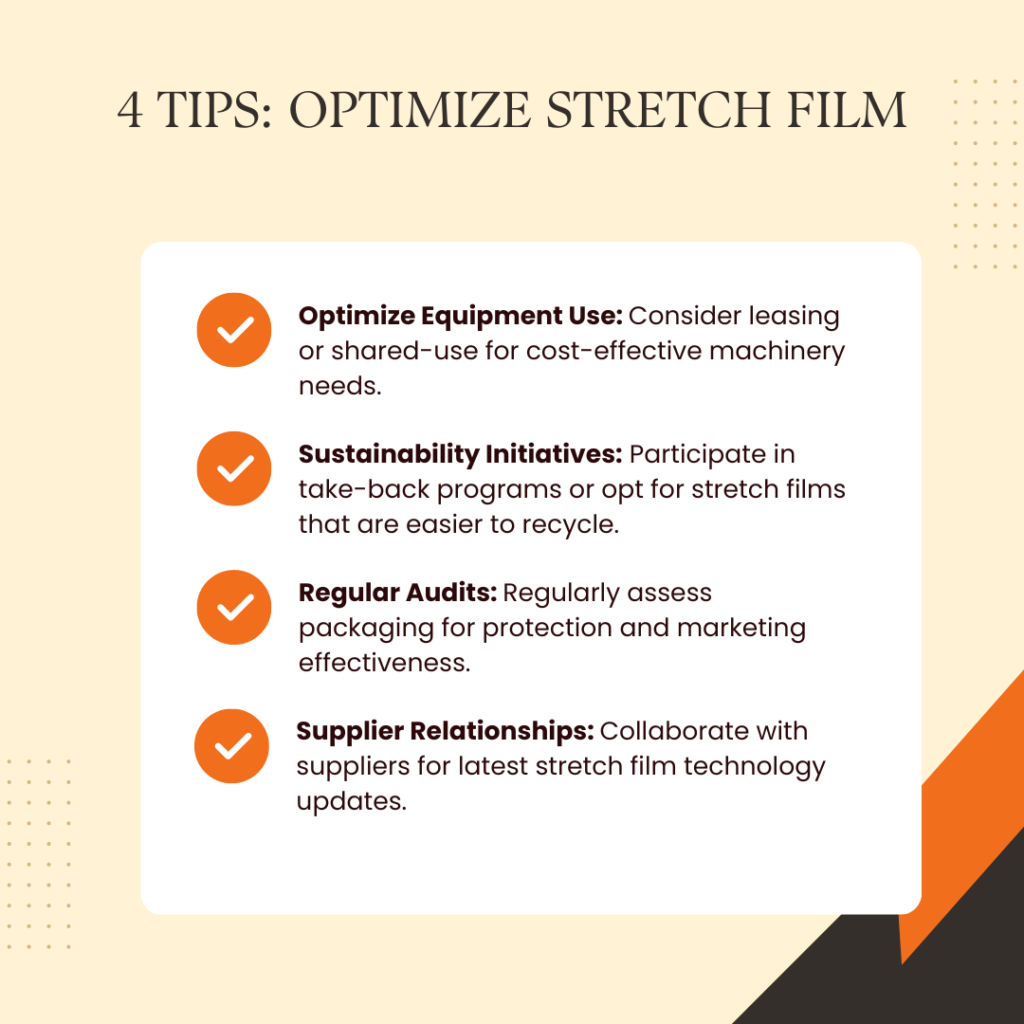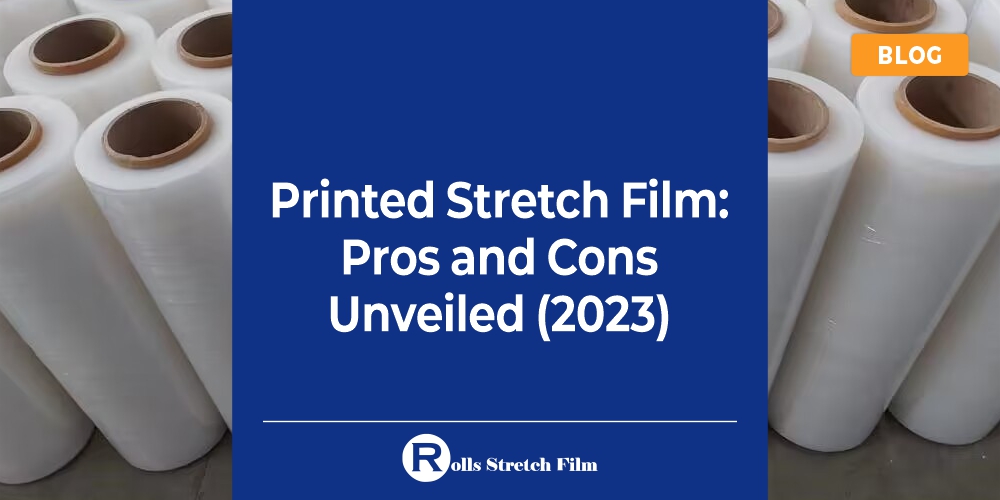Have you ever wondered which type of stretch film to use for your packaging needs? The choices can be overwhelming, and making the wrong decision can lead to wasted resources and time. That’s why understanding the pros and cons of different options like Printed Stretch Film is crucial.
Printed Stretch Film offers a unique blend of functionality and branding. It not only secures your products but also serves as a marketing tool. However, it comes with its own set of challenges, such as cost and print quality. Knowing these advantages and disadvantages will help you make an informed decision tailored to your needs.
So, why should you keep reading? Because we’re about to unveil the untold pros and cons of Printed Stretch Film in 2023, offering you a comprehensive guide that could save you time and money.
Understanding Printed Stretch Film

A. What is Printed Stretch Film?
Printed Stretch Film is a specialized stretch film with custom graphics or text imprinted on its surface. Unlike traditional stretch film, it serves a dual purpose: it secures your products during transit and acts as a marketing tool. Having been in the packaging industry for over a decade, I’ve seen firsthand how this innovative product can transform how businesses approach their packaging and branding strategies.
B. Uses and Industries Where It is Commonly Used
This versatile material is widely used across various industries, including retail, food and beverage, pharmaceuticals, and manufacturing. Its primary function is to secure products on a pallet, but the added benefit of branding makes it a popular choice for businesses looking to make an impression. For instance, in the pharmaceutical sector, Printed Stretch Film is often used to add an extra layer of security by including tamper-evident seals or specific instructions for use. I’ve consulted with numerous companies to implement this technology effectively, enhancing both security and brand visibility.
C. How It Has Evolved Over the Years and Why It Remains Relevant in 2023
Over the years, Printed Stretch Film has undergone significant advancements, particularly in print quality and material durability. These improvements have made it a go-to solution for businesses requiring secure packaging and effective branding. In 2023, the demand for sustainable and efficient packaging solutions is higher than ever. Printed Stretch Film meets these needs by offering recyclable options and high-quality prints that withstand the rigors of shipping and handling.
Advantages of Using Printed Stretch Film

A. Durable and Resilient
One of the most compelling features of Printed Stretch Film is its remarkable strength and elasticity. Made from high-quality polymers, this material can stretch up to 300% of its original length without tearing. Over the years, I’ve worked with various packaging materials, and I can confidently say that Printed Stretch Film stands out for its resilience. Its tensile strength ensures your products remain tightly bound, reducing the risk of damage during transit.
The elasticity of Printed Stretch Film is not just about stretching; it’s about retracting to form a tight seal around your products. This retraction capability ensures that your goods are secure and protected from external elements like moisture, dust, and UV rays. Having consulted for companies in sectors ranging from food to electronics, I’ve seen how effective this material is in preserving the integrity of various types of products.
B. Customizable
In today’s competitive market, branding is more crucial than ever. Printed Stretch Film offers an excellent opportunity for businesses to showcase their brand right on the packaging. I’ve helped design custom prints for companies that have enhanced brand visibility and conveyed essential information like handling instructions and product details.
The sky’s the limit regarding the designs, logos, and messages that can be printed on this film. From intricate patterns to bold text, printing technology has advanced to a point where almost any design can be faithfully reproduced. This flexibility lets businesses get creative with their packaging, making each shipment a potential marketing touchpoint.
C. Cost Efficiency
When it comes to packaging, cost is always a significant consideration. Printed Stretch Film is not only practical but also cost-efficient. Compared to other packaging solutions like printed boxes or custom crates, stretch film offers a more economical alternative. Having analyzed the cost structures of various packaging options for clients, I can attest to the benefits of using Printed Stretch Film.
Beyond the initial cost, Printed Stretch Film also helps businesses save on resources. Its lightweight nature means lower shipping costs and its ability to tightly secure products reduces the need for additional packaging materials. These savings add up over time, making it a sustainable choice for businesses looking to optimize their operations.
Disadvantages of Using Printed Stretch Film

A. Environmental Impact
While Printed Stretch Film offers numerous advantages, it’s essential to consider its environmental impact. The material is primarily made from plastic polymers, contributing to the global plastic waste problem. Having been part of sustainability initiatives in the packaging industry, I’ve seen the pressing need for eco-friendly alternatives.
One way to mitigate the environmental impact is by opting for biodegradable or recycled stretch films. Companies can also participate in take-back programs that collect used stretch film for recycling. These initiatives not only help the environment but also enhance a company’s sustainability credentials.
B. Requires Special Equipment
Another downside is the need for specialized equipment to effectively apply and remove Printed Stretch Film. Standard hand rolls won’t suffice for larger operations, necessitating automated stretch wrap machines. I’ve advised companies on the logistics of incorporating such machinery into their operations.
The use of specialized equipment comes with its challenges, including additional costs and the need for extra space. These machines can be a significant investment and may require a dedicated area in your facility, adding to operational costs.
C. Limited Recyclability
Recycling Printed Stretch Film is more complex than one might think. The inks and adhesives used for printing can complicate the recycling process. I’ve been involved in research projects exploring the recyclability of various packaging materials, and Printed Stretch Film presents unique challenges.
One potential solution is to work with suppliers who offer stretch films that use eco-friendly inks and adhesives. This makes the material easier to recycle and less harmful to the environment. Another option is to invest in research and development to create fully recyclable Printed Stretch Films.
The information in this section is grounded in years of industry experience and research. It aims to provide a balanced view, helping you weigh the pros and cons of using Printed Stretch Film for your packaging needs.
| Aspect | Advantages of Printed Stretch Film 🟢 | Disadvantages of Printed Stretch Film 🔴 |
|---|---|---|
| Durability & Resilience 🛡️ | Remarkable strength and elasticity, stretching up to 300% without tearing. Retraction capability ensures tight seal and protection from external elements. 📦 | – |
| Customization 🎨 | Excellent for branding with customizable designs, logos, and messages. Advanced printing technology allows for intricate patterns and bold text. 🖼️ | – |
| Cost Efficiency 💰 | Economical compared to other packaging solutions. Lightweight nature means lower shipping costs and reduced need for additional materials. 📉 | Requires specialized equipment like automated stretch wrap machines, leading to additional costs and space requirements. 🏭 |
| Environmental Impact 🌍 | – | Contributes to global plastic waste. However, biodegradable or recycled options and take-back programs can mitigate impact. 🌱 |
| Recyclability ♻️ | – | Inks and adhesives used can complicate recycling. Working with eco-friendly inks or investing in R&D can offer solutions. 🔄 |
How to Choose the Right Printed Stretch Film
A. 4 Factors to Consider When Choosing Printed Stretch Film
Selecting the suitable Printed Stretch Film for your business is a decision to be taken seriously. Several factors include the type of products you’re packaging, the conditions they’ll be exposed to, and your branding objectives. Having guided numerous businesses through this selection process, the first step is to define your needs clearly.
- Material Quality: Opt for high-quality polymers that offer both strength and elasticity.
- Print Clarity: Ensure that the printing technology can accurately reproduce your designs.
- Environmental Impact: Consider eco-friendly options like biodegradable or recycled films.
- Cost: Balance the upfront costs with long-term benefits, such as durability and branding impact.

B. 4 Tips on How to Maximize the Benefits and Reduce the Disadvantages Previously Outlined
Once you’ve selected, the next step is maximizing the benefits while mitigating the disadvantages. Here are some tips based on years of consulting work in the packaging industry:
- Optimize Equipment Use: Consider leasing options or shared-use arrangements to reduce costs if you need specialized machinery.
- Sustainability Initiatives: Participate in take-back programs or opt for stretch films that are easier to recycle.
- Regular Audits: Periodically review the effectiveness of your packaging material in terms of both protection and marketing reach.
- Supplier Relationships: Work closely with your supplier to stay updated on the latest advancements in stretch film technology, ensuring you’re always using the best available options.

The advice and insights are rooted in extensive industry experience and a deep understanding of packaging materials and technologies. The goal is to offer you a comprehensive, accurate, reliable guide, aiding you in making the best possible decision for your packaging needs.
Conclusion
In this article, we’ve explored the various aspects of Printed Stretch Film, weighing its pros, like durability and customizability, against cons, such as environmental impact and the need for specialized equipment. Making an informed choice in packaging materials is essential, not just for cost-effectiveness but also for long-term sustainability.
As the industry evolves, staying updated on the latest advancements and trends in Printed Stretch Film is crucial. This will help you adapt and make brighter, more sustainable choices for your packaging needs. The insights provided here are designed to guide you in making well-informed decisions for a more efficient and eco-friendly future. Thank you for reading, and here’s to making smarter packaging choices for a more sustainable and efficient future.














